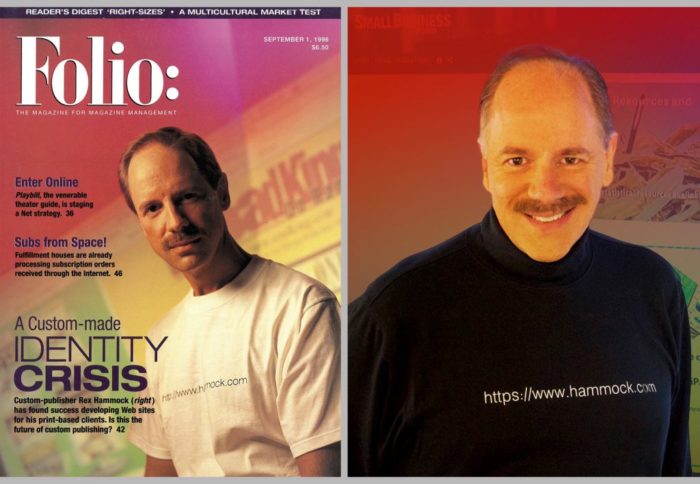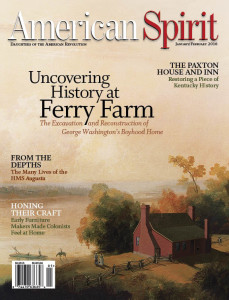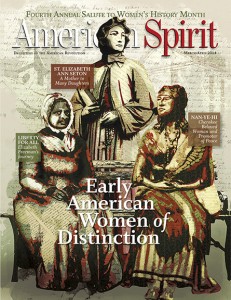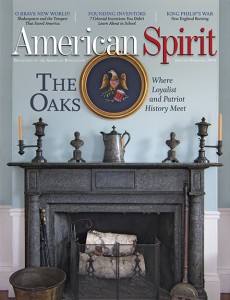



Back in 1996, during the earliest days of the web browser, the magazine-business B2B magazine, Folio:, featured a youthful-looking custom publishing “pioneer” named Rex Hammock on its cover as part of a story on the nascent move by custom magazine companies into digital media. Earlier this week, 20 years later, the author of the first story, Tony Silber, caught up with Rex for an update on whatever happened to that thing called the internet.
Here’s Tony’s introduction to the updated Q&A with Rex. The full story can be viewed here.
In September 1996, nearly 21 years ago, Folio: published a cover story on the state of custom publishing. The article was organized as a quasi-Q&A, posing 10 questions custom publishers were asking themselves at the dawn of the digital age as their businesses were fracturing. Suddenly alien ideas like HTML — and alien platforms like Compuserve and America Online — were emerging, and print-based media services firms were worried about the impact on their business.
The article asked several custom-publishing sources to provide answers for each question. The most prominent of those sources was Rex Hammock, owner of an eponymous custom content agency, and one of the pioneers in a nascent market — using high-quality content in a magazine format as a communications vehicle for marketers. Hammock is also the founder of Rexblog.com, which goes back to the year 2000, and has been consistently and faithfully maintained in all those years — a rare accomplishment by itself, without even considering that it’s also been a media-business thought leader all that time.
Recently, Rex suggested to me that we revisit that Q&A, and try to make sense of the questions and answers from the nineties and seek their corollaries for 2017. The frequently fascinating results follow.
Continued | Foliomag.com
 The May/June issue of American Spirit*, the national magazine of the Daughters of the American Revolution (DAR), visits Lasell Hall, owned by Schoharie DAR Chapter, Schoharie, N.Y. The home, in DAR’s hands since 1912, was severely damaged during the flooding from 2011’s Hurricane Irene. The building has become a signature restoration project for FEMA, but that agency wasn’t the only one to lend funds or a helping hand. Chapter members and the entire community came together to restore the circa-1795 home, including reinstating the original floor plan and many historic paint colors.
The May/June issue of American Spirit*, the national magazine of the Daughters of the American Revolution (DAR), visits Lasell Hall, owned by Schoharie DAR Chapter, Schoharie, N.Y. The home, in DAR’s hands since 1912, was severely damaged during the flooding from 2011’s Hurricane Irene. The building has become a signature restoration project for FEMA, but that agency wasn’t the only one to lend funds or a helping hand. Chapter members and the entire community came together to restore the circa-1795 home, including reinstating the original floor plan and many historic paint colors.
 American Spirit*, the national magazine of the Daughters of the American Revolution (DAR), has a strong track record of spotlighting unique preservation efforts of DAR members and others dedicated to restoring the nation’s iconic places.
American Spirit*, the national magazine of the Daughters of the American Revolution (DAR), has a strong track record of spotlighting unique preservation efforts of DAR members and others dedicated to restoring the nation’s iconic places.
For the January/February 2016 issue, our cover subject is Ferry Farm, the site of George Washington’s boyhood home. After spending almost a century as an endangered site, Ferry Farm is rising again, as a team of archaeologists, historians and volunteers with the George Washington Foundation work to reconstruct the circa-1740 house and uncover new information about the early life of America’s first commander in chief. DAR members have so far raised more than $125,000 for the restoration.
Because of American Spirit’s focus on the lives of Patriots, we don’t often talk about the lives of Loyalists. Some faced mob violence and property seizures because of their allegiance to the Crown, and others changed their allegiances throughout the war depending on their treatment. Fearing persecution after the Revolutionary War, thousands of Loyalists fled to Canada, where they faced new hardships before becoming a vital part of the fabric of their new country.

The current Idea Email explains how and why ad-blocking isn’t just a browser plug-in hack. Blocking ads is also a multi-billion dollar business. It’s based on the notion that advertising doesn’t always need to be at the transaction intersection when dollars are exchanged for content. Oftentimes, customers become so overwhelmed by the crush of ads on the internet and traditional media, they are more than willing to pay media companies for the chance to view (listen to, watch, read) ad-free content.
And many media companies have learned that there are billions of dollars in potential revenue in allowing people to pay for ad-free content, rather than subjecting them to personalized ads or the sheer magnitude of ads that appear on a web page.
Here are some examples of ad-free content providers and how they make money (or hope to).
 In November, 2012, we titled our very first Idea Email with a line inspired by the sentence Apple used to introduce the second generation of the iPad: “Technology at its very best is invisible.”
In November, 2012, we titled our very first Idea Email with a line inspired by the sentence Apple used to introduce the second generation of the iPad: “Technology at its very best is invisible.”
In our version, we substituted “marketing” for the word technology.
In that first Idea Email, we wrote what we still believe to be the goal of great marketing:
The goal of great marketing should be to make the customer smarter, stronger, happier, or whatever the customer wants when they purchase a product or join an association or sign up for a service. When you emphasize how your product can help customers achieve something, they don’t think of it as marketing. They think of it as help. And that’s when marketing is at its very best.
 For four years, American Spirit* has dedicated its March/April issue to Women’s History Month. It’s a particularly enjoyable issue to write, edit and design in partnership with the Daughters of the American Revolution since it gives us a chance to find and promote little-known stories of fascinating women of early America.
For four years, American Spirit* has dedicated its March/April issue to Women’s History Month. It’s a particularly enjoyable issue to write, edit and design in partnership with the Daughters of the American Revolution since it gives us a chance to find and promote little-known stories of fascinating women of early America.
One of those women is a Cherokee “Beloved Woman” named Nan-ye-hi, an influential leader and peacekeeper during a time of great upheaval in the Cherokee Nation. Despite my living in Tennessee–her home and that of her ancestors–for the past 10 years, I had never even heard of Nan-ye-hi until the Nancy Ward DAR Chapter (named after her English name) suggested researching her life for this issue. It was a privilege to share that research with readers.
Our cover was designed to highlight Nan-ye-hi and two of the other diverse and distinguished women featured in this issue. Illustrator Antonio Rodrigues used organic shapes and earthy colors to illuminate Elizabeth Freeman, the former slave who helped abolish slavery in Massachusetts, St. Elizabeth Ann Seton, a pioneer in Catholic education who became the first U.S. citizen to be canonized, and Nan-ye-hi. The subtle background script that fleshes out the illustrations underscores one of American Spirit’s goals: to faithfully record these early American women’s remarkable stories and convey their importance to modern readers.
Another feature is excerpted from Nancy Rubin Stuart’s book, Defiant Brides: The Untold Story of Two Revolutionary-Era Women and the Radical Men They Married. Stuart details the moments that Lucy Flucker Knox and Peggy Shippen Arnold met their Revolutionary husbands Henry Knox and Benedict Arnold, and hints at ways the women’s initially parallel lives eventually diverged.
It’s Mardi Gras season, so it’s fitting that we travel to Louisiana for two stories: Our Historic Homes department visits Laura Plantation, a French Creole sugar plantation that was run by several strong-willed women in the 19th century, and Spirited Adventures checks in on Natchitoches, the oldest permanent settlement in the Louisiana Purchase.
*For more than a decade, Hammock has been honored to assist the National Society Daughters of the American Revolution in publishing their award-winning magazine. Anyone can subscribe here.
 Every issue of American Spirit* invites readers to learn more about a historic home–and its owners–particularly those with connections to the Colonial or Early American period. Gracing the January/February cover is The Oaks, a Worcester, Mass., home finished at the end of the Revolution by Judge Timothy Paine and later occupied by his son, Dr. William Paine. Both Paines were Tories, but, ironically, the home is now owned and preserved by the Colonel Timothy Bigelow DAR Chapter, named for the Revolutionary minuteman, prisoner of war and military commander.
Every issue of American Spirit* invites readers to learn more about a historic home–and its owners–particularly those with connections to the Colonial or Early American period. Gracing the January/February cover is The Oaks, a Worcester, Mass., home finished at the end of the Revolution by Judge Timothy Paine and later occupied by his son, Dr. William Paine. Both Paines were Tories, but, ironically, the home is now owned and preserved by the Colonel Timothy Bigelow DAR Chapter, named for the Revolutionary minuteman, prisoner of war and military commander.
Another feature honors the French-born Patriot Comte de Rochambeau. He forged an effective partnership with George Washington and played an integral role in the British defeat at the Siege of Yorktown.
We delve into law and order, early-American-style, for a feature on Virginia statesman George Wythe. We investigate the mysterious circumstances of this Patriot’s painful death, probably at the hands of his ne’er-do-well grandnephew.
 Population health was foremost on our minds as we prepared the Q4 issue of The Source, the magazine we help HealthTrust publish for healthcare supply chain professionals. Healthcare systems and physicians groups are developing new programs aimed at population health management, a systematic approach to addressing the preventive, high-risk and chronic care needs of patients, with a goal of minimizing costly interventions like emergency room visits, hospitalizations and readmissions. We interview Dr. David Nash, of the Jefferson School of Population Health in Philadelphia, on this healthcare paradigm shift. As the founding dean of the first designated school of population health in the country, Nash is considered one of the leading experts in the field.
Population health was foremost on our minds as we prepared the Q4 issue of The Source, the magazine we help HealthTrust publish for healthcare supply chain professionals. Healthcare systems and physicians groups are developing new programs aimed at population health management, a systematic approach to addressing the preventive, high-risk and chronic care needs of patients, with a goal of minimizing costly interventions like emergency room visits, hospitalizations and readmissions. We interview Dr. David Nash, of the Jefferson School of Population Health in Philadelphia, on this healthcare paradigm shift. As the founding dean of the first designated school of population health in the country, Nash is considered one of the leading experts in the field.
Jeff Cornwall, Belmont University entrepreneurship professor and longtime blogger (The Entrepreneurial Mind), recently invited Rex Hammock to appear on the video version of his blog — a show produced by the Nashville-based web video network, Talkapolis. In the 10 minute episode, Rex explains the customer media and content focus of Hammock Inc. — and our role in the context of today’s marketing landscape.


The companies that really know how to use customer media content—to create and deepen relationships with customers, not just to fulfill some checklist of sales and marketing materials—have a few things in common.
From our work and research, here are 10 traits of companies setting the benchmark for using customer media and content that works: